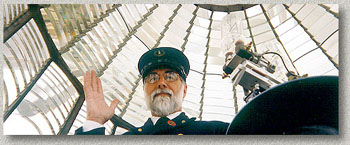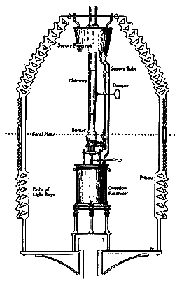The Lens

Here it is! I'm standing inside the light-house's First-order Fresnel Lens. The Henry-Lepaute optical company made it in France. This lens has 1,008 separate lenses and prisms, each was ground and polished by hand to exacting specifications and carefully mounted in a brass framework. It is six feet in diameter, seventeen feet high, and the entire lens weighs more than four tons. By the late 1880's a first-order-light apparatus cost about $4,250 to $8,400.
Today the lens has this electric lamp mechanism to light it. It was installed about 1926 when electricity became available to this part of the California coast. There are two 1,000-watt lamps in the fixture; one that would be in operation during the night, and a back-up lamp that would swing into place if the first one failed. These electric bulbs increased the light from the 160,000 candlepower of the earlier pressurized kerosene system, installed in about 1912, up to a blazing 680,000 candlepower!

This is a simple drawing of the lamp and lens equipment I worked with. Sorry to say the lamp is not around anymore either. It was a "Funck's Hydraulic Float Lamp" of the First-order. It was made of brass and glass and beautiful to see. It was named after Mr. Joseph Funck. He was the foreman of the Light-house establishment's workshops at the main depot on Staten Island, New York.
The First-order model had four concentric wicks to concentrate as much light as possible in the center of the lens. We would burn about 20 to 25 yards of each size wick every year. The sizes of the wicks were:
1 inch in the center
1 7/8 inch
2 11/16 inch
3 9/16 inches
Remember earlier when I talked about the lard oil that we had to carry up the stairs each night for the open burner lamp? This lamp used that lard oil. As you can see from the drawing, the lamp was much bigger than the electric equipment and was as tall as the interior of the lens. As impressive as it was, it only produced about 70,000 candlepower of light. This was far less than the later kerosene and electric lighting systems.
As usual, the Light-house establishment gave us very detailed instructions on how to light the lens. Here is a small sample of those instructions:
To light a lamp, commence by raising the wick about one-third of an inch above the top of the burner, and light it at two opposite points, using for that purpose the small hand lamp (Lucerne) specially designed for lighting.
As soon as the flame commences to rise all around, and before it begins to smoke, lower the wick, and place the chimney in its holder. At first keep the wick low and the chimney high; afterward raise the wick to its proper height, and lower the chimney to its position, in succession, until a clear white flame is obtained at such height as the description of lamp requires.
To light lamps with two or more concentric wicks, commence with the inner one, which should be lowered as much as possible (without risk of extinguishing the light) as soon as it has caught all around; follow that same course with the next wick; having lighted all the wicks in regular order as prescribed for the inner one, commence raising them gradually and lower the chimney at the same time.
The flame of a burner of two or more concentric wicks requires about half an hour to reach its full development. Having lighted all the wicks and lowered them as directed, place the glass chimney on the burner and put on the damper; and then raise the wicks gradually, using the chimney and damper for obtaining the best and highest possible flame. The greatest height of flames of Funck's float-lamp, with lard oil for a First-order lamp, was 4 inches.
If a wick is elevated above a proper point, the flame may grow larger, but it will be dull and red; if the error is in the contrary direction, the flame will continue to be white, but without attaining such a height as is desired. For a light-house, just being seen wasn't enough. You also had to be easily identified in some way. This was important so sailors on ships would know which light-house they were looking at. Not only was it important for a light-house to be seen, each light-house had to be uniquely identifiable. That's why these vertical panels of prisms and lenses are so important. This round lens called "bull's eyes" produces a shaft of light called "pencil beams." Remember I said earlier that this lens has 24 panels? The pencil beam created by the bull's eye in each of those panels produced 24 spokes of light from the lens.
Here's why it's important to turn the lens at a precise rate. The lens made one complete rotation every four minutes with its 24 spokes of light. If you were looking at the lens from a fixed position, you would see a "flash" every 10 seconds. Four minutes (240 seconds) divided by 24 panels/spokes of light means a spoke of light would go by you every ten seconds. A flash every ten seconds was, and still is, Pigeon Point's signature or "characteristic." In the 19th Century 17 different signatures were in use by light-houses on the West Coast of the United States.
